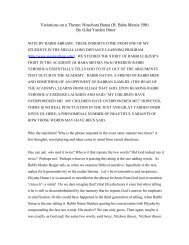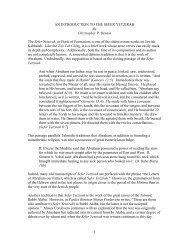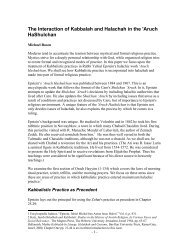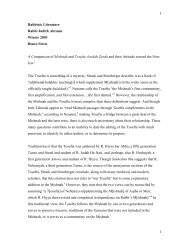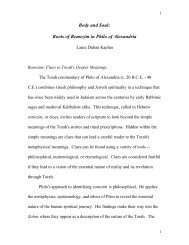The Symbolic Representation of the Sefer Torah - Maqom
The Symbolic Representation of the Sefer Torah - Maqom
The Symbolic Representation of the Sefer Torah - Maqom
You also want an ePaper? Increase the reach of your titles
YUMPU automatically turns print PDFs into web optimized ePapers that Google loves.
congregations, after <strong>the</strong> <strong>Torah</strong> scroll is unrolled, <strong>the</strong> wimple was brought to <strong>the</strong> women’s section and <strong>the</strong>women would fold <strong>the</strong> sash, passing it from one to ano<strong>the</strong>r and thus giving all <strong>the</strong> women a chance to feelan attachment to <strong>the</strong> <strong>Sefer</strong> <strong>Torah</strong>. On <strong>the</strong> whole, women were a passive participants in <strong>the</strong> synagogue, <strong>the</strong><strong>Torah</strong> reading and rituals as well as <strong>the</strong> general prayer service. This was a woman's opportunity to beactive. Not only <strong>the</strong> folding <strong>of</strong> <strong>the</strong> sash but <strong>the</strong> whole process <strong>of</strong> its preparation was an occasion for womento physically feel connected to <strong>the</strong> holiest <strong>of</strong> Jewish artifacts, <strong>the</strong> <strong>Torah</strong> scrolls.Discussion and ConclusionThis essay has focused primarily upon customs and rituals <strong>of</strong>fering <strong>the</strong> majority <strong>of</strong> <strong>the</strong> congregants<strong>the</strong> opportunity to interact with <strong>the</strong> <strong>Sefer</strong> <strong>Torah</strong> and its sacred nature. Rudolf Otto (1958, pp. 5-7 andthroughout <strong>the</strong> entire monograph) discusses <strong>the</strong> concept <strong>of</strong> “holy” above and beyond <strong>the</strong> traditionalrational understanding <strong>of</strong> "goodness." He introduces <strong>the</strong> word “numinous” to “first, to keep <strong>the</strong> meaningclearly apart and distinct, second to apprehend and classify connectedly whatever subordinate forms orstages <strong>of</strong> development it may show.” By "numinous" he meant <strong>the</strong> numinous category <strong>of</strong> value as well as<strong>the</strong> numinous state <strong>of</strong> mind which is reflected in feeling. He explains (p. 12) “it grips or stirs <strong>the</strong> humanmind with this and that determinate affective state.” <strong>The</strong> numinous also contains <strong>the</strong> “mysteriumtremendum” (mystical awe) which includes <strong>the</strong> element <strong>of</strong> awe or <strong>the</strong> feeling <strong>of</strong> fear or religious dread,<strong>the</strong> fear <strong>of</strong> G-d or <strong>the</strong> representation <strong>of</strong> <strong>the</strong> holy. One may experience a personal state <strong>of</strong> submission andself surrender before an awe-inspiring unapproachable object, an object which becomes attractive andfascinating. This object can be inanimate, and <strong>the</strong> extraordinary capability to evoke feelings <strong>of</strong> <strong>the</strong> “whollyo<strong>the</strong>r or consciousness” is attributed to it (Otto. 1958, p, 27). <strong>The</strong> identification with a religious object canmotivate varied feelings or expressions such as passion, excitement, vitality and impetus. One can feel thissensation without a clear concept or expression <strong>of</strong> what this evokes. <strong>The</strong>se mindsets will motivate <strong>the</strong>individual to bring <strong>the</strong> numen into his circle or have physical contact with <strong>the</strong> numinous object. Otto(1958, p. 33) argues “possession <strong>of</strong> and by <strong>the</strong> numen becomes an end in itself.”36



